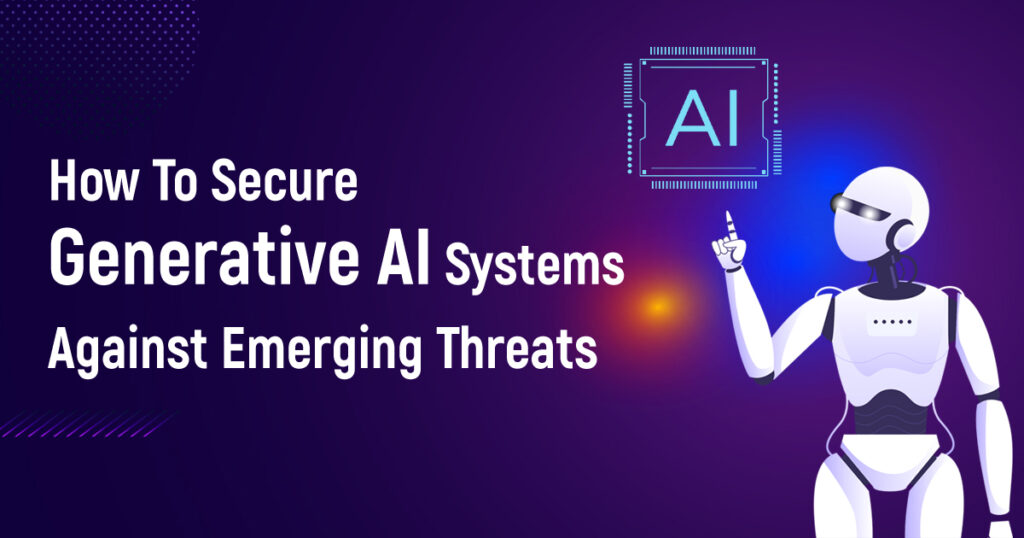Generative AI, driven by advanced machine learning techniques, is revolutionizing industries by creating text, images, music, and virtual environments. These systems showcase remarkable creativity and practical applications, from automation to scientific research.
However, as generative AI evolves, it encounters new and varied threats, including adversarial attacks, data poisoning, model inversions, and ethical abuses. Securing generative AI systems requires a specialized approach that addresses both traditional cybersecurity concerns and these emerging vulnerabilities.
Understanding the Threats to Generative AI Systems
Adversarial Attacks
Involve manipulating input data to trick AI models into producing incorrect or harmful output. For generative AI, this could mean producing misleading or harmful results. Attackers can introduce subtle perturbations (such as a small change in images or text) to the data input that cause the model to produce very different and potentially harmful results.
Data Poisoning
This occurs when attackers inject malicious data into the training dataset of an AI model. For generative AI programs, toxicity data can lead to biased, inaccurate, or harmful information. This attack can be particularly tricky because it destroys the model at its core, potentially affecting all subsequent production.
Model Inversion Attacks
This allows attackers to reconstruct the input data used to train the model and potentially reveal sensitive or confidential information. For generative AI, this can mean removing proprietary data or intellectual property from the model without permission.
Ethical and Social Risks
In addition to technological threats, reproductive AI also poses ethical and social risks, such as profound information, misinformation, and information that reinforces harmful biases, and these risks can have far-reaching consequences, such as erosion of trust in AI systems and broader social problems.
Strategies to Secure Generative AI Systems

Robust Adversarial Training
To reduce the risks of adversarial attacks, hostile systems should be trained, where models are exposed to hostile information during the training process, thereby helping the model learn how to recognize and resist such changes.
Data Integrity Checks and Poisoning Mitigation
It is important to ensure the accuracy of the training data and prevent data poisoning. This includes the use of strong data validation procedures, the use of anomaly detection techniques to identify and eliminate suspicious data, and the use of differential privacy techniques to protect the model, and no single data point was affected.
Securing Model Architecture and Outputs
Protecting the model’s architecture and objects from unauthorized access is critical. This includes encrypting model parameters, using access controls to restrict who can interact with the model, and using watermarking techniques to trace output origins.
Ethical AI Governance
Establishing a robust ethical governance framework to address the broader social and ethical risks of reproductive AI is essential. This includes developing policies around the responsible use of AI, developing guidelines for content development, and ensuring transparency in AI use.
Continuous Monitoring and Incident Response
Even with robust security measures in place, AI systems must continue to be monitored to detect emerging threats and respond in real-time. The use of advanced monitoring tools that can monitor unusual or unexpected activity can help detect threats early.
The Role of Policy and Regulation in Securing Generative AI
As generative AI continues to evolve, so must the regulatory frameworks governing its use. Governments and regulatory agencies play an important role in setting standards for AI safety and ethics. Businesses operating in this area should be informed about relevant regulations such as the GDPR and ensure that their AI infrastructure complies with these standards. In 2024 and beyond, we can expect increased scrutiny of AI programs, including ensuring that generative AI is used responsibly and safely. Companies must engage actively, and engagingly with the regulatory industry and help develop AI security standards.
Building a Secure Future for Generative AI
The potential of reproductive AI is great, but so are the risks if these systems are not properly maintained. By understanding the specific threats in AI-enabled fertility and implementing robust security measures, companies can harness the power of AI while mitigating associated risks. As AI technology advances, eyes remaining vigilant and flexible will be key to maintaining security.
By taking a proactive approach to securing generative AI, businesses can not only protect themselves from emerging threats but also build trust with consumers, stakeholders, and the broader public. The future of AI is bright, but it is up to us to ensure that it is also secure.












